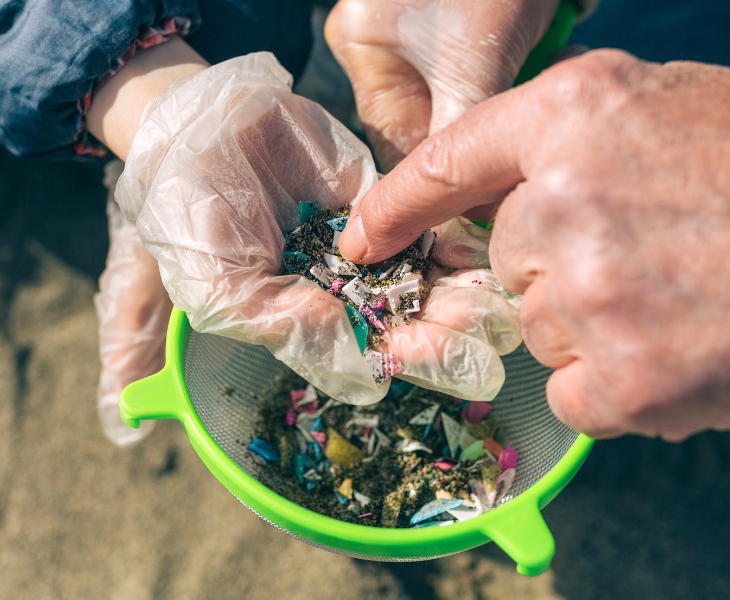Microplastics are everywhere, from the products we use, the clothes we wear, and the food and water we consume. Microplastics are small plastic particles that are less than 5mm in size and are found in the oceans, waterways, and the air we breathe. Approximately two-thirds of all plastic ever produced is still present in the environment, most of it in the form of microplastics, tiny toxic particles that pollute the air, soil, and rainwater. According to an international team of researchers, the top foot of the ocean contains between 82 and 358 trillion plastic particles, or over 1.1 to 4.9 billion kilograms of microplastic floating around the world.
Microplastics can be divided into three types based on their origin:
- Primary microplastics: These are small plastic particles manufactured for use in a variety of products such as cosmetics (microbeads used for exfoliation), personal care products, and industrial abrasives. Microbeads in exfoliating scrubs, glitter, and plastic pellets used in plastic production are examples of primary microplastics. In a study conducted by the International Union for Conservation of Nature (IUCN), the main sources of microplastics found in the world’s oceans were synthetic textiles (35%), tires (28%), city dust (24%), road markings (7%), marine coatings (4%), personal care products (2%), and plastic pellets (0.3%).
- Secondary Microplastics: These are larger plastic items like plastic bags, bottles, fishing nets, and straws that decompose into smaller and smaller pieces over years (this could take up to 500 years), but remain in our waterways and landfills forever.
- Microfibres: These are the invisible plastic fibres shed by synthetic fabrics such as polyester in our shirts. According to a 2015 Environmental Science & Technology report, just one 500g fleece jacket can produce a staggering 250,000 fibers in just one wash!
Microplastics can also be classified based on their size:
- Large microplastics: Ranging from 1 to 5 mm.
- Small microplastics: Ranging from 100 nm to 1 mm.
- Nanoplastics: Less than 100 nm in size.
Health Impacts of Microplastics on Marine Life and Humans
Fish, seabirds, and whales are just a few of the marine animals that mistake microplastics for food. When plastic is ingested into their body, it can build up in their digestive tracts, leading to blockages and internal damage that can lead to fatalities.
According to a 2019 study published in the journal of Environmental Science and Technology, the average human consumption of microplastic ranges between 39,000 and 52,000 each year. Microplastic chemicals can have a wide range of health consequences for humans, resulting in developmental, reproductive, and hormonal issues. Microplastics can also act as a carrier for pathogenic bacteria, which is transmitted to humans through ingestion.
Tips for Reducing Microplastics in your Everday life:
1. Reduce single-use plastic bottled water
Microplastic is present in both tap water and bottled water, but researchers have found that bottled water has twice as many microplastic particles as tap water. In 2018, a State University of New York study examined 259 water bottles from 19 different locations across nine different countries and discovered that 93% of the samples contained microplastics.
It is highly recommended to use reusable water bottles made of alternative materials, such as glass or stainless steel, to reduce exposure to microplastics from bottled water. Or look for a reliable water filtration system that can remove contaminants from tap water. There are many options available on the market, including under-sink filters, countertop filters, and pitcher filters. Make sure to choose a filter that can effectively remove microplastics from the tap water.
2. Cut out takeaway cups
In Australia, over 1 billion disposable coffee cups are used every year, adding up to 2.7 million per day. A Chinese research team led by Sichuan University discovered that drinking a single cup of takeaway coffee per week can expose a person to over 90,000 microplastic particles per year.
Although many takeaway cups are made of paper, they are coated with a thin layer of plastic, such as polythene or polypropylene to make them leak-proof. This plastic coating has the potential to degrade into microplastics over time, especially if the cups are exposed to heat or moisture. If you drink coffee every day in a takeaway cup, chances are you might be consuming microplastic daily. Most of these paper cups have linings made of HDPE grade plastic, which is regarded as “safe,” but has been shown to leak estrogenic chemicals.
Invest in a reusable coffee cup made of recycled material, stainless steel or glass to use at your preferred coffee shop. Bringing your own mug helps reduce waste, and many cafes offer discounts to customers who use their own reusable cups.
3. Dispose of waste correctly
Plastics that are not properly disposed of can end up in our oceans and waterways, where they degrade into microplastics over time. Remember that putting your recyclables in a plastic bag will prevent them from being recycled! To properly dispose of them, simply toss everything into the recycling bin. Avoid purchasing products with excessive packaging to reduce your waste output. Purchase products with minimal packaging or packaging that is easily recyclable.
4. Opting out plastic food containers
According to a study by the Journal of Hazardous Materials, hot plastic food containers release more than 10 million microplastics per ml of water. In the study, it was also observed that plastic food packaging constantly releases micro- and nanoplastics.
Individuals who order takeout food five to ten times a month are calculated to be consuming anywhere between 145 and 5,520 microplastic pieces as a result of atmospheric sediment or fragments from the inner plastic container surface.
To limit your exposure to harmful chemicals, avoid microwaving food in plastic containers and use microwave-safe glass, biodegradable containers, ceramic bowls, or paper towels to cover the food. Another option is to order your takeout food from sustainable vendors who provide eco-friendly or reusable containers. You can also reduce your overall exposure to microplastics by avoiding single-use plastics and choosing reusable alternatives whenever possible.
5. Choose eco-friendly cleaning products
You can help promote a healthier workplace environment and reduce the risk of microplastic exposure for both employees and the environment by using eco-friendly cleaning products in the office. Microbeads and other microplastics that are harmful to the environment and human health are typically not found in eco-friendly cleaning products.
Choosing eco-friendly cleaning products made from natural, biodegradable ingredients that degrade quickly and do not pollute the environment can also help in promoting ethical and sustainable business practises. Moreover, eco-friendly cleaning products are packaged in recyclable or biodegradable materials, which can help reduce waste and keep plastic out of the environment.

